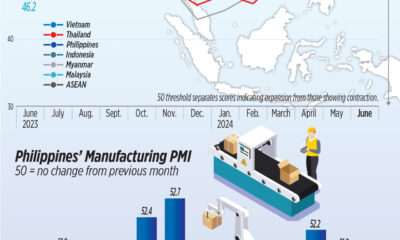Business
Eurozone’s first-quarter growth provides relief from ‘stagflation’ concerns

The eurozone is experiencing a notable increase in economic growth in the first quarter of 2024, the fastest pace in two years, easing concerns about ‘stagflation’ that threaten to sweep across the region.
Eurozone output grew by 0.3 percent in the first three months of the year, a significant improvement on the stagnant growth recorded in the previous quarter. This growth figure, the strongest since the 2022 Ukraine crisis, exceeded the expectations of economists, who had expected a more modest growth of 0.1 percent.
Data from Eurostat, the European Union’s statistical agency, shows that annual consumer price inflation remained stable at 2.4 percent in April, consistent with March figures and in line with forecasts. This stability in inflation, the lowest since July 2021, provides further reassurance amid economic fluctuations.
Melanie Debono, senior Europe economist at Pantheon Macroeconomics, notes the surprising strength of the recovery, signaling a departure from the superficial recession at the end of the previous year.
The positive momentum in the first quarter signals a turnaround for the eurozone, especially after disruptions in major economies such as Germany due to energy and industrial challenges following the Russian invasion of Ukraine, coupled with inflation rising above 10 percent. These developments come ahead of the upcoming European Union elections in June, which will mark the first vote since Britain left.
Among the standouts, the Republic of Ireland emerges as the fastest growing economy within the bloc, with a remarkable growth of 1.1 percent. However, factors such as measurement differences and the volatility caused by foreign direct investment from US technology giants headquartered in the country contribute to Ireland’s unique economic landscape. Other notable performers include Lithuania, Latvia, Spain and Portugal, each showing robust growth rates.
Core inflation, excluding volatile food and energy prices, fell marginally from 2.9 percent to 2.7 percent, while services inflation eased from 4 percent to 3.7 percent in April compared to the same period last year.
The encouraging economic data provides a breather for policymakers at the European Central Bank (ECB), who are deliberating on interest rate adjustments following the region’s recession, against the backdrop of higher borrowing costs. With the next ECB decision expected on June 6, financial markets expect a 60 percent chance of monetary policy easing, the first step in that direction since 2020. However, a growing economy and record-low unemployment levels could create new inflation problems.
Amid global economic dynamism, China is also seeing a positive rebound in manufacturing activity, with April witnessing the fastest growth in fourteen months, driven by increased new export orders. While this is a sign of progress for China’s recovery, challenges remain in domestic demand and the real estate sector.
Despite China’s robust GDP growth of 5.3 percent in the first quarter, which exceeded analyst expectations, March indicators point to persistent weaknesses in industrial profits, retail sales and real estate transactions, hampering the country’s ambitious growth target. approximately 5 percent before 2024 may be hampered.













